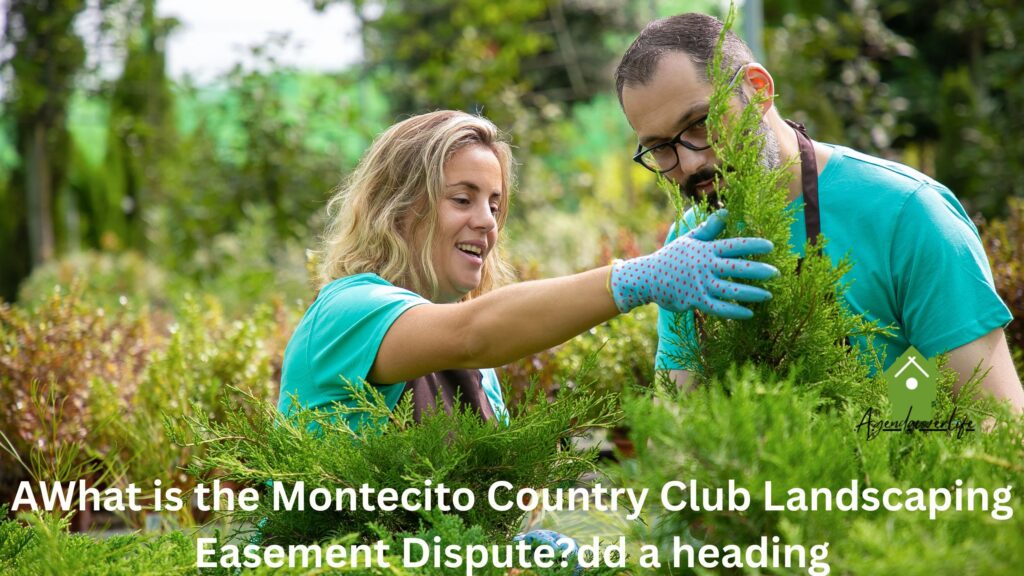
Alright, so here’s the deal in simple terms. The Montecito Country Club, owned by billionaire Ty Warner (yes, the Beanie Babies guy), has been around for years with its sprawling landscape, golf greens, and manicured vibes. But near their neatly trimmed hedgerows lies land that technically isn’t theirs to play with. Enter the easement.
For those scratching their heads, an easement is kind of like agreeing to share your driveway with your neighbor. It’s still yours, but someone else can use it for specific reasons. Back in 1977, an easement was recorded, saying the Montecito Country Club gets to use this strip of land for things like cart paths and keeping their greens pristine.
Fast forward to 2018 when the Roots, lovely homeowners over at 1059 Summit Road, move in. Fast forward again to 2020. The Roots decide to spruce up their yard – new hedges, some regrading (that’s fancy talk for reshaping the land), and adding a retaining wall. Sounds innocent, right? Except, oops, part of all that spruce-up action encroaches on that 1977 easement land.
And here’s where things go downhill fast. The club notices, sends them warnings, and eventually takes them to court. Suddenly, what started as “just gardening” turns into a battle between big-money real estate interests and homeowners just trying to make their home look nice.
Why Should You Care About Easements?
Okay, so maybe you’re thinking, “Great story, but I don’t live in Montecito, and I don’t have an easement in my backyard.” But here’s the thing, friend – easements aren’t just a Montecito thing. They’re everywhere.
Think of situations like sharing a driveway, an access path, or even parts of your land that utility companies use for power lines or sewer connections. Easements can pop up in unexpected places, and they might not always be obvious when you first buy a property. And once you step on an easement, figuratively speaking, things can get messy.
Easements matter because they’re all about boundaries. They can dictate who gets to do what with a chunk of your property. Knowing about them is step one to protecting yourself, your wallet, and yes, your stress levels.
The Timeline of Montecito’s Dispute
Want to know how this all unfolded? Here’s a quick-and-snappy timeline of the Montecito drama for context:
- Pre-2020 – The Montecito Country Club enjoys dancing along the fine print of its 1977 easement. Life is peaceful.
- Early 2020 – The Roots decide to level up their yard. They remove a hedgerow, add some dirt for regrading, and install a retaining wall. No big deal…or so they think.
- Mid-2020 – The club notices the changes and gives them a verbal nudge, like, “Hey, this might be a problem.”
- 2021 – Warnings turn to written notices after the Roots keep landscaping. By June 2021, the case lands in Santa Barbara Superior Court.
- July 2024 – The decision drops. Judge Donna Geck rules in favor of the club. The Roots are told to remove all their fancy landscaping, restore the area to its pre-2020 state, and shell out the costs themselves. Cue the tears and stressed sighs from Summit Road.
This isn’t just a timeline; it’s a giant spotlight on what happens when property rights and modernization collide!
FAQ Section
- What’s the point of an easement?
Easements make sure certain pieces of land can serve a purpose for someone else, whether it’s parking, walking paths, or infrastructure upgrades. - Can you fight an easement?
Sure, you can, but it usually comes down to what’s on paper. If an easement is legally recorded in your deed/documents, it’s staying. - What should I do if I discover an easement on my property?
First, don’t panic. Talk to a real estate lawyer or property surveyor. They’ll decode the fine print and help you make sense of what it means for you.
Why This Case Isn’t Just Headlines
This landscaping drama might seem like a Montecito issue, but it’s a reminder for everyone else to keep their eyes sharp on what’s buried in their property documents. It’s not just about land boundaries; it’s about balancing the past agreements with modern-day needs.
Stay tuned because there’s so much more to unravel here. For now, take a pause and consider this: Before you pick up your garden shears or plot your dream backyard, maybe, just maybe, check if you’re stepping onto unknown legal ground. Better safe than in court, right?
Coming up in the next section, we’ll dig deeper into homeowner preparedness and practical tips to prevent a courtroom clash over your own slice of paradise. Stay with me!
What Exactly is an Easement, and Why Does it Matter?
Okay, hold on to your hats because we’re about to demystify easements. Sure, it might sound like a word only lawyers love, but trust me, it’s not as complicated as it seems. Picture this: You’re the proud owner of a beautiful home, complete with a gorgeous backyard. But, surprise! There’s a slice of your land that someone else has a legal right to use. That’s an easement.
Think of it like this. Imagine you have a pie. It’s your pie; you baked it, and you’re totally looking forward to eating it. Then, your neighbor says, “Hey, I’ve got dibs on one slice of that pie because we made an agreement ages ago.” You can still enjoy most of your pie, but that slice? It’s not just yours anymore. That’s exactly what an easement feels like for property owners.
Breaking Down Easements in Simple Terms
Easements are like shared agreements over land. A property owner (you, in this example) still technically owns the land, but someone else gets to use it for a specific reason. It could be a neighbor, the city, or, in the case we’re exploring, the Montecito Country Club. Easements can be used for anything from driving over a shared path to running utilities under your backyard.
There are different types of easements, too. Here are the big ones without overwhelming you:
- Right of Way Easement:
This is the classic “you can cross my land to get to yours” scenario. It’s like letting the delivery driver cut through your yard when the street is blocked. - Utility Easement:
These are the sneaky ones you don’t think much about. Your electrical, water, and cable lines often run through parts of your land, but guess what? That means utility companies get to access those areas, too. - Prescriptive Easement:
This one gets spicy. It’s when someone uses your property for so long (without your permission!) that they eventually gain legal rights to keep doing it. Could you imagine? - Conservation Easement:
This one’s more noble. It’s when land is preserved for ecological purposes. Picture lush meadows or forest land that’s protected from development.
Now that you know the basics, you can see how easements are a big deal. If you’re not aware of them, they can turn into costly surprises. Enter the saga of the Montecito Country Club.
How the Easement Sparked the Landscaping Drama
Here’s where the Montecito debacle ties into all this. The country club holds a 1977 easement on the Roots’ property, meaning they’ve had the legal right to use it for their own purposes. All those landscaping upgrades the Roots made? Well-intentioned though they may have been, they disrupted the easement. By reshaping the land, regrading, adding hedges, and building retaining walls, the Roots unintentionally blocked the club’s access to their easement.
It’s like lending your friend a tiny section of your yard for their kids to play in, only to find out later they can’t access it anymore because you decided to install a pool. The friend (in this case, the Montecito Country Club) understandably gets upset because the deal no longer works in their favor.
Here’s where things get extra tricky. Easements can’t just be ignored or erased. They stick like glue to the property, following the land rather than the owner. This means that as long as the Montecito Country Club easement is in place, it doesn’t matter who owns the property at 1059 Summit Road. Those rules stay untouched.
Why Ignoring Easements is a Risky Gamble
Thinking you can brush off an easement agreement? Bad idea! Easements are enforceable in court, as the Roots quickly learned. They might seem like a piece of paperwork that doesn’t matter much, but in reality, they can have a massive impact on property rights and disputes.
Not knowing about an easement can lead to:
- Unnecessary legal battles (hello, courtroom fees!).
- Costly repairs or restorations to bring property back to “agreed-upon” conditions.
- Conflict with neighbors or organizations.
Easements are like house guests; they might only take a small corner of the house, but they’re not going anywhere unless the original agreement allows it.
FAQs About Easements
Now, I know what you’re probably wondering. Here are some common questions to clear things up:
- Can an easement be removed?
Sometimes, yes. If all the involved parties agree to end an easement or it’s no longer needed (say, a utility company moves their lines elsewhere), it can be removed. But, spoiler alert, it’s not easy. - What happens if I accidentally block an easement?
Mistakes happen! The best thing to do is fix the issue sooner rather than later. Reach out to the easement holder and negotiate a solution. If it goes to court, as we see in the Montecito case, expect to make costly restorations. - How can I find out if my property has easements?
Check your property deed or title report. These documents should outline any easements attached to the land. Oh, and pro tip? Hire a property surveyor or lawyer to give those documents a good run-through before buying a home. - Why should I care about easements as a homeowner?
Easements matter because they affect how you can use your land. They also impact property value, which is no small thing when it comes to real estate.
Easy Ways to Protect Yourself from Easement Surprises
Dealing with easements doesn’t have to be scary. With a little awareness and preparation, you can dodge the kind of drama we’re seeing in Montecito. Here’s how:
- Do Your Homework
Before you buy a home, demand a title report. This will save you from unexpected surprises lurking in the fine print. - Get Professional Help
Bring in a property lawyer or surveyor to comb through the details. Their expertise can save you a headache down the road. - Communicate Clearly With Neighbors
Most easement headaches begin with poor communication. Share concerns or changes openly so everyone’s on the same page. - Understand Your Limits
You can’t block or modify an easement without permission from all involved parties. No matter how tempting it might be to “just trim those hedges.”
At the end of the day, easements are simply agreements that help people (and land) co-exist. They’re not inherently bad, but neglecting them can lead to issues faster than you can say “courtroom.” For the Roots, it’s an unfortunate lesson learned the hard way. For you, it’s a chance to get ahead of the game!
As we move forward, we’ll talk about the legal rulings in this particular case and how community dynamics play into the overall story. But for now, remember this: Knowing what to expect is half the battle. Easements might sound boring, but if you skip the fine print, you could end up tangled in disputes that are far from dull. Stay tuned for more insights!









